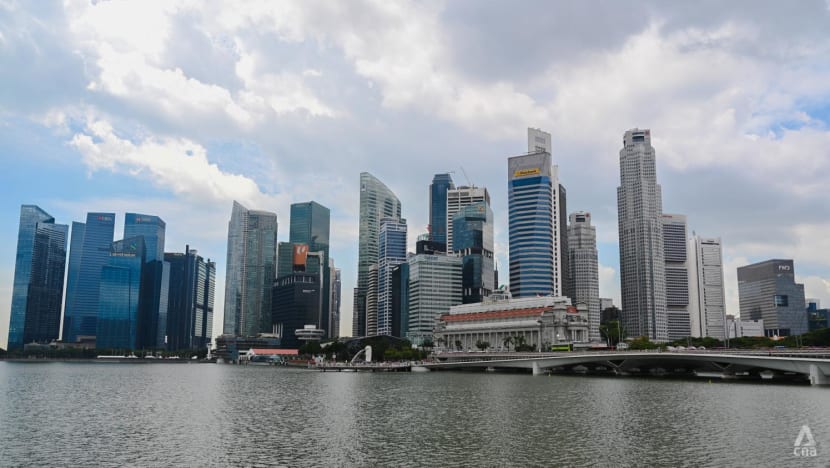MAS pauses monetary policy tightening to focus on economic growth, say analysts
Economy watchers say the central bank’s tightening cycle has come to an end amid growing fears about global growth and ebbing inflation.

Buildings in Singapore's central business district on Nov 16, 2022. (File photo: CNA/Hanidah Amin)
SINGAPORE: After being laser-focused on taming inflation, the Monetary Authority of Singapore (MAS) shifted gears on Friday (Apr 14) with a pause on monetary policy tightening as it considers growing risks confronting the economy, experts said.
The economy is already showing signs of hitting the brakes, with advance estimates for the first quarter of 2023 indicating that year-on-year growth was 0.1 per cent, a sharp slowdown from 2.1 per cent in the preceding quarter.
"Growth momentum has slowed significantly while inflation has peaked, and likely to moderate going forward. The changing risk dynamics between growth and inflation has prompted the MAS to rebalance its exchange rate policy,” said a note from DBS Group Research.
A PAUSE IN THE TIGHTENING CYCLE
The MAS, which uses the exchange rate as its main policy tool, said it will “maintain the prevailing rate of appreciation” of its Singapore dollar nominal effective exchange rate (S$NEER) policy band. There will also be no changes to the width and the mid-point of the band, it added in its half-yearly policy review.
Unlike most central banks that target interest rates, the MAS manages monetary policy by letting the local dollar rise or fall against the currencies of its main trading partners within an undisclosed band, known as the S$NEER. It adjusts its policy by changing the slope, mid-point and width of the policy band.
Friday’s decision marks the first time in more than a year that the MAS is standing pat on monetary policy, after making five consecutive tightening moves since October 2021 to tame inflation.
While inflation remains elevated, the central bank said its previous tightening moves have tempered the momentum of price increases, with the effects “still working through the economy and should dampen inflation further”.
It also said that by the end of the year, imported inflation will turn more negative and core inflation is expected to ease materially.
Additionally, it warned of the risk of a “deeper than anticipated” domestic economic slowdown amid “intensifying risks” to global growth.
Maybank economists described the statements as a signal that concerns about a growth slowdown “seem to be outweighing inflation”, while others noted that the MAS has turned "dovish".
Central bankers are typically described as "dovish" when they favour an expansionary monetary policy, such as the cutting of interest rates, to support economic growth and employment.
“Overall, the statement took a dovish turn from its October (monetary policy statement) as concerns on Singapore's growth prospects this year seems to take priority,” said a note from OCBC Treasury Research.
Related:
WEAKENING ECONOMIC GROWTH
Concerns about the economy are aplenty, according to economists.
Externally, global growth is slowing, which will in turn take a hit on global trade and demand. This is a “bleak” outlook for the Singapore economy, which is among the most exposed to a global downturn and weak external demand, said Capital Economics' economist Shivaan Tandon.
Already, the key manufacturing sector is feeling the heat, contracting 6 per cent year-on-year in the first quarter, worse than the 2.6 per cent contraction in the preceding quarter.
The sector, which makes up about one-fifth of Singapore's economy, is also grappling with an ongoing downturn in the global semiconductor industry.
“Singapore has a large electronics sector so not only is the economy highly exposed to weak global demand, it is also vulnerable to weak global electronics demand,” Mr Tandon said.
“This is likely to compound the weakness in exports and will weigh on the domestic labour market too through weaker employment.”
The pause in the central bank’s tightening cycle is aimed at giving exports some support, said MUFG Bank’s senior currency analyst Jeff Ng.
“If it continues to tighten, exports may become less competitive as they become more expensive. In turn, we may see less demand for our goods and services, which can cause the downturn to worsen," he added.
Beyond manufacturing, economists are also concerned by hints of weakness in the services sector.
Advance estimates showed the wholesale and retail trade, as well as the transportation and storage sectors, collectively contracted 1.1 per cent year-on-year in the first quarter, reversing the 2.4 per cent growth in the quarter before.
The information and communications, finance and insurance, and professional services sectors grew by 1.9 per cent year-on-year, nudging down from the 2.5 per cent growth in the preceding quarter.
While holding up on the back of travel resumption and economies reopening, the accommodation and food services, real estate, administrative and support services, as well as other services cluster saw a moderation in growth, from 9 per cent in the fourth quarter of last year to 6.7 per cent in the first quarter of 2023.
Overall, the services producing industries grew 1.8 per cent in the first quarter, against 4 per cent in the preceding quarter.
Apart from the decline in the externally-oriented services industries, Mr Ng noted that the modern services cluster is currently feeling the impact of a downturn in the technology sector. The cluster also faces the possibility of “some volatility” from the recent upheavals in the global banking sector.
“With services accounting for two-thirds of the Singapore economy, the weakness in at least two out of three clusters is a concern,” the analyst told CNA.
The worse-than-expected numbers on Friday have led to growth downgrades by several financial and research houses.
For instance, Capital Economics now expects the Singapore economy to grow 0.5 per cent in 2023, compared to its previous forecast of 1 per cent.
Warnings of a technical recession, defined as two consecutive quarters of quarter-on-quarter contraction, have also emerged after advance estimates showed the economy contracting by 0.7 per cent in the first quarter of 2023, on a quarter-on-quarter seasonally-adjusted basis.
“Singapore’s (gross domestic product) has effectively slowed to below trend in the first quarter, which may persist in the second quarter given the headwinds seen in manufacturing and trade,” said RHB senior economist Barnabas Gan in a research note.
Maybank economists noted that Singapore “risks entering into a technical recession if the boost from China’s reopening fails to materialise in the second quarter”.
END OF TIGHTENING CYCLE: ECONOMISTS
Economists also predicted that the MAS has likely reached the end of its tightening spree.
Mr Tandon cited expectations for inflation to “fall markedly” moving forward.
“Given the economy is set to grow below-trend and recession risks are elevated, we believe demand-side pressures in the economy are set to cool markedly,” he said.
He also pointed to other indicators, such as wage growth which slowed sharply in the fourth quarter and a decline in job vacancies throwing up signs of labour market softening. As such, the economist sees core inflation possibly retreating back to 2 per cent by year-end.
Mr Gan agreed that the MAS’ statement likely marks the end of Singapore’s tightening cycle, unless there are renewed inflation risks from an unexpected exacerbation of geopolitical tensions and intensified supply chain congestions.



















